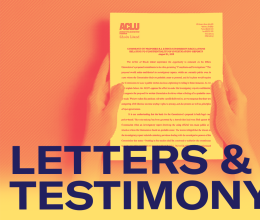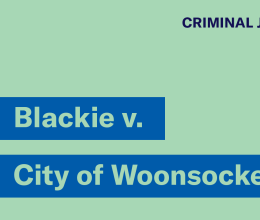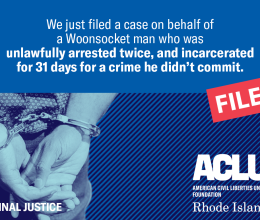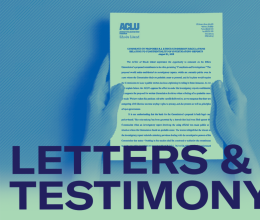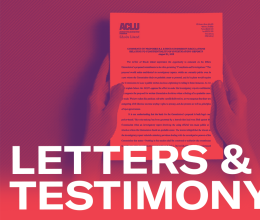Saying that many questions remain unanswered, the ACLU of Rhode Island today issued a five page commentary on the Thursday shooting of Joseph Santos by Providence and RI State Police after a high speed chase, precipitated by the belief that the car had a connection to the theft of a police cruiser earlier that morning by an escaped suspect, Donald Morgan. At this point, no connection between the two incidents has been established.
The ACLU analysis responds to the information provided by Providence and State Police at separate news conferences at which they expressed full confidence that their officers acted properly at all times. “In the absence of additional information,” states the ACLU analysis, “it would be wrong to blame the police for what they did, but it is just as inappropriate for police officials to so quickly conclude that there is no fault by police for what happened either.”
Among the issues and questions raised by the ACLU’s analysis:
* THE HIGH SPEED CHASE. Little attention has been paid to the question of the propriety of the high-speed chase that ultimately led to Santos’ death. The pursuit not only endangered the motoring public, but there are questions as to whether it conformed to the high-speed pursuit policies of the Providence Police Department (PPD) and the R.I. State Police (RISP).
* THE USE OF DEADLY FORCE. The PPD claims that the suspect, after being blocked in by police, posed “an imminent threat of death or serious physical injury” by ramming the cars in front and behind in order to get away. But, the ACLU commentary states, “this argument would seem to prove too much. The suspect was trying to get away from the police-initiated chase, not intentionally seeking to cause harm. Under the PPD’s reasoning, deadly force would therefore seem to be justified in any instance of a high-speed pursuit, even where the police chase itself was what led to the danger.”
The PPD high-speed policy also requires that in using lethal force, there must be a “reasonable belief” that “the lives of innocent people will not be endangered.” Did the barrage of bullets aimed at the car on the highway meet this standard?
* FACTUAL QUESTIONS ABOUT INITIATING THE HIGH SPEED CHASE. It is crucial to know exactly what the police bulletin, which went out to officers and prompted the initial stop of Santos’ car, said about escapee Donald Morgan. For example, did the bulletin note that the State Police were aware that the gun in the stolen police cruiser had been recovered and that Morgan was still handcuffed? In addition, the broadcast apparently referred to the suspect white pick-up truck as a Ford F-150, but Santos’ car was an F-250. Were police looking for the wrong model of car the whole time? Answers to questions like these are important in fully evaluating the actions by the police in this case.
* TRANSPARENCY. The PPD is to be commended for releasing body camera footage of the incident, but it is a cause of concern that this was done only as a matter of discretion, not policy. The PPD is also to be commended for releasing the names of the officers involved in the shooting. However, the decision by RISP to withhold all troopers’ names until an investigation is completed represents a glaring and troubling lack of transparency, and also runs afoul of the Access to Public Records Act.
* POLICE BODY CAMERAS. Three Providence officers present for the shooting were equipped with body cameras, but only one of the cameras was activated. Was this at least partly due to the PPD’s own policy, about which the ACLU has previously expressed concerns, governing the activation of the cameras?
In calling for answers to these various matters, the ACLU analysis states that “whenever deadly force is used, and particularly in situations where it results in the death of an unarmed civilian, it is crucial that the situation and the circumstances be scrutinized with care.”
The analysis concludes by saying: “We fully recognize the difficulties officers face in quick-moving situations like this. It is critical to examine the totality of the circumstances before judging the actions of the police in this case. In the absence of additional information, it would be wrong to blame the police for what they did, but it is just as inappropriate for police officials to so quickly conclude that there is no fault by police for what happened either. . . . We hope that in the coming days, the questions we have raised will be addressed and more detailed explanations about the actions taken by both the city and state police will be provided.”

